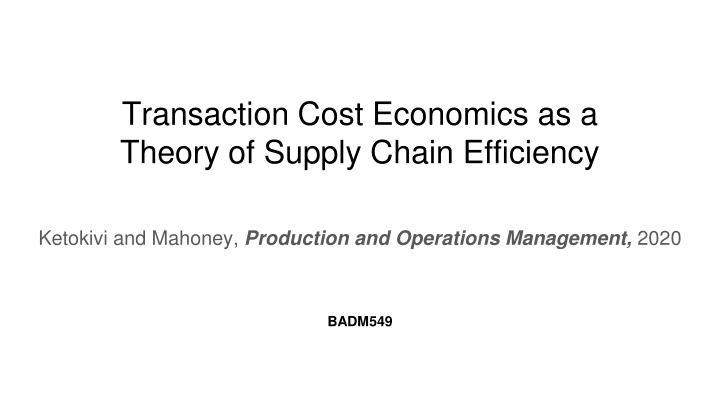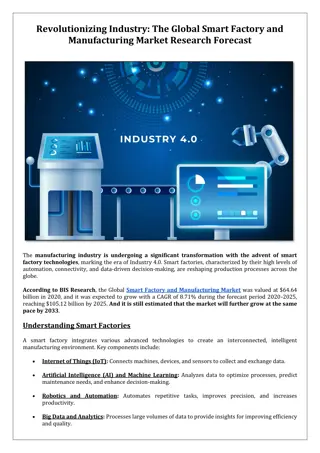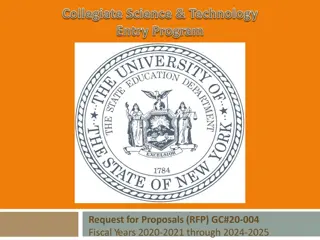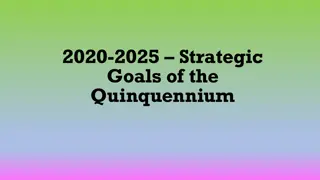
Transaction Cost Economics in Supply Chain Efficiency
Explore the application of Transaction Cost Economics (TCE) in supply chain management, highlighting the misconceptions and opportunities for future research. Learn about the relationship between TCE and operations/supply chain management and how it differs from competence-based theories. Uncover the relevance of TCE in making governance choices for transactions and exchange relationships within supply chains.
Download Presentation

Please find below an Image/Link to download the presentation.
The content on the website is provided AS IS for your information and personal use only. It may not be sold, licensed, or shared on other websites without obtaining consent from the author. If you encounter any issues during the download, it is possible that the publisher has removed the file from their server.
You are allowed to download the files provided on this website for personal or commercial use, subject to the condition that they are used lawfully. All files are the property of their respective owners.
The content on the website is provided AS IS for your information and personal use only. It may not be sold, licensed, or shared on other websites without obtaining consent from the author.
E N D
Presentation Transcript
Transaction Cost Economics as a Theory of Supply Chain Efficiency Ketokivi and Mahoney, Production and Operations Management, 2020 BADM549
Research Motive - - - Researchers misunderstand and misapply TCE s aims, assumptions, and logic. Researchers mistakenly read TCE as a theory of competence or power. TCE is a theory of efficient governance of transactions and exchange relationships. Purpose of this paper (1) Clarify the misunderstanding by reviewing the theoretical foundations of TCE, its aims, and its applicability as a theory of supply chain efficiency. (2) Generate opportunities for future contributions of supply chain management scholars to broader, cross-disciplinary conversations.
TCE and Operations/Supply Chain Management - - Common interest: the interaction between economic entities The make or buy decision makes TCE applicable to research on operations and supply chain management Choice of governance choice from an efficiency perspective Make Hybrid Buy In-source from internal suppliers Franchising Equity joint ventures Outsource from external suppliers Hierarchy (vertical integration) Market
Summary of the Three Theoretical Lenses of Supply Chain - The competence view consists of the majority of research in operations and supply chain management. (Tsay et al. 2018)
- Opportunities for TCE-based studies exist, but TCE-based articles fail to adopt TCE s key concepts and logic, resulting in narrow application. Limitations of Current Research in OSCM - Also, references to TCE are merely perfunctory or ritualistic or used just for setting empirical context. - Confounding the efficiency view of TCE with the competence- based and power views.
Competence - Make or buy decisions based on relative competence. Is the firm more capable of manufacturing than its potential external suppliers? How the heterogeneity of firms competencies influences firm-level heterogeneity in economic performance DV: measures of economic value creation and capture IV: heterogeneous capabilities Unit of analysis: legal entity (firm or a unit) Objective: explain and predict heterogeneity among entities and its implications for heterogeneous economic performance. Topics: value creation, comparative advantage, competitive advantage, persistent above-normal economic profits, etc E.g., Amazon third-party seller service; Zara fast fashion manufacturing - - - - - - -
- Focuses on actors who can exert power on others in the supply chain - For example, a sizeable final assembler can squeeze its small suppliers by setting prices Actors in the supply chain avoid dependence on a specific actor (supplier). Unit of analysis: simultaneously examine several organizational entities (firms). Topics: power, bargaining power, resource dependence, etc. Power - - -
Efficiency View (TCE) - Assumption: transacting parties share the mutual interest of organizing the transaction economically to increase value creation. Premise: effective management of transactions requires efficient governance. Identification, explication, and mitigation of contractual hazards Looks beyond production costs and focuses on governance costs: ex-ante and ex-post costs (Coase 1937) associated with the exchange. Daily execution of complex contracts requires monitoring, adjustment, enforcement, renegotiation, etc. Make or buy decisions based on comparing production cost advantage and governance cost. Relentlessly Comparative - - - -
Asset Specificity The degree to which an asset can be deployed to alternative uses/users without sacrificing productive value. The higher the sacrifice, the higher the asset specificity. Such lock-in gives rise to relational contracting. (1) site specificity: geographical co-location. Once sited, the assets are immobile. (2) physical asset specificity: investments in equipment specific to the transaction (3) human capital specificity: relationship-specific human capital through learning-by- doing processes (4) temporal specificity: assets must be handled in a timely manner (5) dedicated assets: investments in production capacity for a set volume. Excess capacity results are problematic even without physical asset specificity.
Transactions and Governance Structures - TCE focuses on economizing (reducing waste), like OSCM s lean manufacturing and swift and even flow. - OSCM focuses on economic efficiency, which is directly linked to productivity. However, they abstract the productivity impact of efficient governance. - Discriminating alignment hypothesis: transaction characteristics are aligned with governance structures. Much empirical evidence exists. - Institutions consist of formal rules (laws, property rights) and informal constraints (sanctions, customs). A change in the formal rules can change the characteristics of efficient governance of hierarchy.
The Case of Automobile Assembly (GM and Adient) - - Automakers are final assemblers that outsource the components. GM outsources seat production to Adient because of Adient s comparative production advantage and aggregation economies of scale and scope There also are significant governance costs due to these three transactional factors - 1. Asset specificity. Production location in proximity to GM s final assembly line. 2. Uncertainty: tech, demand, behavioral. Contingent claims contracts are infeasible. 3. Frequency of trading: how often Aident delivers to GM
Bounded Rationality and Opportunism - Contracts are incomplete due to bounded rationality, behavior that is intendedly rational, but only limitedly so. (Simon 1997) Bounded rationality involves neurophysiological limits (cognition) and language limits (communication) (Williamson 1975) cannot simply chuck psychology overboard and place the theory of organization [solely] on an economic foundation. Opportunism: acting selfishly in bad faith, outside the rules of the game. Because of bounded rationality, knowing ex-ante who will act opportunistically is impossible. Thus, transacting parties should seek to safeguard the exchange relationship - - - - -
Discrete Market Transactions for Simple Transactions - Simple transactions are handled more effectively as discrete market transactions that rely on the price system. - When transactions entail high asset specificity, managing the exchange via relational contracts involves high governance costs. - When the governance cost exceeds the advantage of outsourcing, it is more efficient to do it internally (hierarchy). - Conflicts between the internal supplier and the final assembler can be addressed internally, not involving courts.
Bilateral Dependence and Credible Commitments - In contrast to theories of power, TCE posits that over time, both transacting parties are mutually locked-in. Because of bilateral dependence, GM would not act opportunistically to jeopardize the relationship. Holdup problems: When a powerful opportunistic buyer takes advantage of a relationship-specific investment by a supplier. Even though holdup problems exist, forward-looking exchange parties will adopt and commit to ex-ante safeguards. Realized holdup problems are outside the scope of TCE Credible commitments: Should not confuse it with trust - - - -
Fundamental Transformation - Even if the market were perfectly competitive, relationship specificity might still develop through experience and learning in the buyer-supplier relationship. - Small numbers bargaining, where firms become bilaterally dependent, affects contract renegotiation and switching costs. - TCE predicts existing suppliers to have an advantage over new bidders in renegotiation because of the fundamental shift (relationship specificity)
- Higher incentive intensity: The advantage of discrete market transactions over internal exchange is that markets assign responsibility to individual actors more efficiently, reducing bureaucratic distortions. Incentive Intensity - Application limits: treating production units and warehouses as cost centers (sticking to the budget), not profit centers, leads to lower- powered incentives.
The Future of TCE - More recent topics of TCE go beyond cost minimization and discuss adjustment costs, opportunity costs, and revenues, which align with topics in OSCM. - Scaling up : does the repeated application of a mechanism out of the original context still yield plausible results? TCE should scale up to explicate economic organization more broadly.
How Can OSCM Contribute to Broader Cross-Disciplinary Conversations? - OSCM ignores policy and antitrust issues (anticompetition). OSCM has the data and detailed understanding of business models, supply chain organizations, and supply chain strategies. They have the potential to contribute to policy conversations. - General management literature often ignores the micro-level processes and nuances that OSCM deals with. OSCM researchers are equipped with the skills and direct measures to elucidate these processes and structures, complementing the examination of statistical relationships among relevant variables. - Also, scholars in OSCM can contribute to treating asset specificity as an endogenous variable.






















